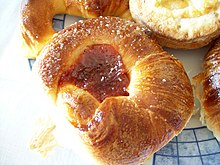Danish pastry
This article needs additional citations for verification. (April 2010) |
 A glazed apple danish | |
| Type | Sweet bread |
|---|---|
| Place of origin | Austria |
| Region or state | Vienna |
| Main ingredients | Flour, yeast, milk, eggs, butter |
A danish pastry, sometimes abbreviated danish especially in the USA, is a viennoiserie pastry, of Viennese origin, which has become a specialty of Denmark and neighbouring Scandinavian countries.
It is called wienerbrød (Danish pronunciation: [ˈʋiːˀnɔˌbʁœːˀð], lit. "Viennese bread", corresponding to the French Viennoiserie) in Denmark, Finland, Iceland, the Faroe Islands, Norway and Sweden. It is referred to as facturas in some Spanish speaking countries.
In Vienna, the danish is referred to as "Plundergebäck" or "Golatschen". Like other viennoiserie pastries, such as croissants, danishes are made of laminated yeast-leavened doughs, creating a layered texture similar to a puff pastry.
Composition

The ingredients include flour, yeast, milk, eggs, and copious amounts of butter. In industrial production, other fats are also commonly used, such as hydrogenated sunflower oil (known as "pastry fat" in the UK). A yeast dough is rolled out thinly, coated with butter, and then folded into numerous layers. If necessary, the dough is chilled to ease handling. The rolling, buttering, folding, and chilling is repeated several times to create a dough which is fluffy, buttery and flaky. However, not all danishes are made this way.
The danish as consumed in Denmark can be topped with chocolate, sugar or icing, and may be stuffed with either jam, marzipan or custard. Shapes are numerous, including circles with filling in the middle (known as "Spandauer's"), figure-eights, spirals (known as snails), and the pretzel-like kringles.
In the UK, various ingredients such as jam, custard, apricots, raisins, flaked almonds, pecans or caramelized toffee are placed on or within sections of divided dough, which is then baked. Cardamom is often added to increase the aromatic sense of sweetness.
In the US, danishes are typically given a fruit or sweet bakers' cheese topping prior to baking.[1] Danishes with nut fillings are also popular.
In Argentina, they are usually filled with dulce de leche or dulce de membrillo.
History

The origin of the danish is ascribed by the Danish Confectioners, Bakers and Chocolatemakers Association to a strike amongst the bakery workers in Danish bakeries in 1850. The strike forced Danish bakery owners to hire foreign workpower. Among these were several Austrian bakers, who were unfamiliar with the Danish baking recipes, and therefore baked pastries of their native homeland recipes. Amongst these Austrian pastries were Plundergebäck, which became quite popular in Denmark. Later this recipe was changed by Danish bakers, increasing the amount of fat (by adding more egg) which resulted in what is today known as the danish.[2]
United States

Lauritz C. Klitteng, of Læsø, Denmark, popularized "danish pastry" in the United States in the years 1915-1920. The danish was, according to Klitteng, the dish that he baked for the wedding of United States President Woodrow Wilson in December 1915. Klitteng toured the world to promote his product, and he was featured in such 1920 periodicals as the National Baker, the Bakers' Helper, and the Bakers Weekly. Klitteng opened a short-lived Danish Culinary Studio at 146 Fifth Avenue in New York City.[3]
Herman Gertner owned a chain of New York City restaurants, and Gertner brought Klitteng to New York to sell Danish pastry. Gertner's obituary appeared in the January 23, 1962 New York Times:
At one point during his career Mr. Gertner befriended a Danish baker who convinced him that Danish pastry might be well received in New York. Mr. Gertner began serving the pastry in his restaurant and it immediately was a success.
Cartoon controversy
During the Jyllands-Posten Muhammad cartoons controversy in 2006, several religious Iranian groups advocated changing the name of highly popular danish (Shriniye Danmarki), given its name association with the source country of the offending cartoons.[4] The Iranian confectioners' union designated "Roses of the Prophet Muhammad" as the new name for danishes made in the country as of 15 February 2006, although compliance with the proposed name in bakeries was mixed and short-lived.[4] Related to this, many protesters in several Muslim countries, angered by the pictures of Muhammad, boycotted Danish goods. "Roses of Muhammad" (Persian: گل محمدی "gole mohammadi", literally: Muhammed flower) is a traditional Persian synonym for variety of pink rose flowering shrub.
See also
- Kringle (Kringel)
- Danish cookie
- Danish cuisine
- Pastry
- Doughnut
References
- ^ Cheese Recipes: Bakers Cheese
- ^ "Wienerbrød". Arbejdsgiverforeningen Konditorer, Bagere og Chocolademagere. Retrieved 2012-17-01.
{{cite web}}: Check date values in:|accessdate=(help) - ^ Jorden rundt med morgenbrød (in Danish). 1944. Retrieved 2011-10-16.[unreliable source?]
- ^ a b "Iranians rename Danish pastries". BBC News. 2006-02-17. Retrieved 2008-04-08.
External links
- Danish Pastry from food historian Barry Popik
